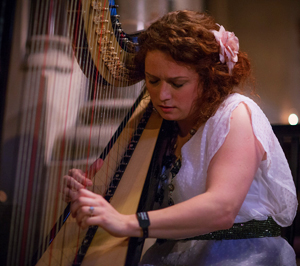Matthew Halsall Gondwana Orchestra raise spirits at The House of St. Barnabas
Thursday, June 19, 2014
The House of St.

is one of Soho’s secret corners: a Georgian townhouse with a Victorian chapel whose turrets look far older, and more suited to the neighbourhood’s French heritage, it has been devoted to the poor since Victorian times. Ex-Straight No Chaser editor Paul Bradshaw, introducing the first of three summer jazz gigs in the chapel, remembers it as a halfway house for the homeless. It says something for changing times that the homeless are helped more indirectly now, with St. Barnabas no longer a literal house for them in increasingly exclusive Soho, but a non-profit members’ club, which funds education for the homeless. The chapel’s partly candlelit, marble-walled, beautiful intimacy is still an ideal home for Matthew Halsall & The Gondwana Orchestra’s spiritual jazz.
Tonight’s set is almost wholly drawn from Halsall’s just-released fourth album, When The World Was One. The exception is opener ‘Music For A Dancing Mind’, led off by keyboardist Taz Modi’s rippling gospel-blues riffs, which settle into a hushed, swaying, two-note rhythm alongside Gavin Barras’ bass, as drummer Matt Davies (standing in for the album’s Luke Flowers) rattles the sides of his kit, echoing in the church. Halsall, in T-shirt and military-style cap, is too bashful to truly take centre-stage, but his Miles-recalling mournfulness on trumpet does end with a clarion cry.
The general Gondwana sound is, though, restfully contemplative, meant for the slowing, not racing, pulse. Just as Halsall’s previous album, Fletcher Moss Park, was inspired by the titular place of meditative sanctuary in his native Manchester, so When The World Was One began with his travels in Japan. Keiko Kitamura’s presence on koto (a high-strung, long wooden instrument) adds an element of authenticity to ‘Kiyozimu-Dera’, named after one of Japan’s oldest Buddhist temples. More importantly, the dry, almost clacking, entwined vibrations of the koto’s strings are a sound of surprise as they hang in the air. Kitamura’s solo to end the first set transfixes the crowd.
 Before that, a touch of funk bass from the early ‘70s – the Gondwana Orchestra’s touchstone era – begins ‘Falling Water’. Then Jordan Smart’s sinuously circular soprano sax phrases and a comforting Halsall solo characteristically fall away in favour the slow ripple and rustle of brushed drums, bass and Rachael Gladwin’s harp (pictured).
Before that, a touch of funk bass from the early ‘70s – the Gondwana Orchestra’s touchstone era – begins ‘Falling Water’. Then Jordan Smart’s sinuously circular soprano sax phrases and a comforting Halsall solo characteristically fall away in favour the slow ripple and rustle of brushed drums, bass and Rachael Gladwin’s harp (pictured).
The harp’s presence is one nod to a major Halsall heroine, name-checked on ‘A Tribute to Alice Coltrane’, in which the band’s pacific waves lap at a languid spiritual jazz centre. They occasionally remember to kick things up, too. Smart abandons his hypnotic sax sway to blaze through a blur of notes on ‘Sagano Bamboo Forest’, where Halsall’s mute gives a dirty, wah-wah rasp, and Kitamura plucks a torrent of bent notes one-handed. ‘Patterns’ is another tune where Halsall finds fire to contrast with the liquid flow, before sinking and shrinking into a hunch-shouldered finish. His fingers flicker over the valves on ‘Jura’. Then he finds a lonesome, soulful tone for the hip, almost Brubeckian urban bustle of ‘When The World Was One’, where Smart briefly blows at his hottest.
Humility, beauty and melodic clarity are the goals of all this virtuosity, letting the mind float free while the head gently nods. With a crucified Christ suspended directly above the band as they play these Buddhist-inflected, black American-indebted sounds, we’ve been taken to a very broad church.
– Nick Hasted
– Tom Oldham (photos)
The Journey to the One Summer Jazz series continues at The House of St. Barnabas with Sun Ra 100 With the London Art Collective on 7 July